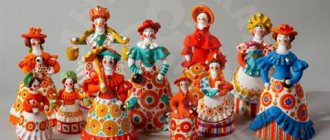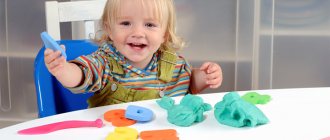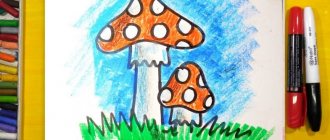MAGAZINE Preschooler.RF
Project: Folk toyDescription of the slides and slide contents for the presentation.
Slide No. 1. The theme of the project is “Folk Toy”
author: Kalinina Altynay, teacher of the first qualification category, MBDOU "Kindergarten No. 120", Syktyvkar, Komi Republic, 2019
Slide number 2. Project passport.
Project name: Folk toy.
Addressing the project: children 3-4 years old.
The goal is to introduce children to Russian folk culture through arts and crafts.
Type of project - informational and creative, group, short-term
Participants - teachers, children of the 2nd junior group, parents (legal representatives) of pupils.
Integration of educational areas: artistic-aesthetic, social-communicative, cognitive, speech, physical development.
Slide number 3. Relevance of the project
The problem of the modern generation is the displacement of traditional folk toys by heroes and characters from foreign animated series. Store shelves are filled with a variety of fantastic, colorful, funny, and absurd toys. Most modern parents give preference to these toys, forgetting to introduce their children to traditional folk toys.
Arts and crafts are the most relevant way for children to perceive the “beautiful” , “beautiful” , “folk” . Folk toys are an inexhaustible source of wise and creative pedagogy. This is a means by which we, adults, can convey to children the socio-historical experience of our people, talk about the traditions and customs passed on from the older generation to the younger. Researchers of children's fine arts: N.P. Sakulina, T.S. Komarova, N.B. Khalezova and others noted that children’s acquaintance with works of folk arts and crafts stimulates in them the first vivid ideas about the Motherland, its culture, and contributes to the education of patriotic feelings. Through the beauty of folk art, the child experiences positive emotions: feelings of joy, admiration, delight. The first vivid ideas about the Motherland and its culture are formed. Therefore, there is a need to introduce the younger generation to folk toys, as one of the manifestations of folk art.
Slide number 4. Introducing a toy at a preschool educational institution
In preschool educational institutions, familiarity with folk toys occurs from a very early age. In the subject development environment of the group there are nesting dolls, tumblers, parsley, etc. Basically, these toys serve as fun toys. The tasks of OOP in preschool educational institutions include introducing children to decorative activities, however, there are not many tasks for visual activities, due to the age characteristics of children.
We made the assumption that systematic work in this direction will help solve this problem. This means that we will increase the level of children’s knowledge about folk toys, introduce them to traditions, folklore, fairy tales, and songs of the Russian people. Learning modeling and painting will allow us to achieve fine arts skills in children and awaken interest in folk art. Children will learn to recognize and create patterns on different shapes.
We determined the theme of the project - “Folk Toy” and developed an action plan, including three main blocks: Matryoshka, Dymkovo toy, Filimonovskaya toy.
Slide number 5. Objective of the project
The goal of the project: introducing children to Russian folk culture through arts and crafts.
Tasks:
- teach to see beauty in works of folk art (folk toys: Dymkovo, Filimonov, matryoshka, household items, clothing);
- to develop interest in the history, traditions, and folklore of the Russian people;
- introduce children to the traditions of Russian culture through folk tales, proverbs, sayings, book illustrations;
- develop aesthetic feelings and artistic perception, promote the emergence of positive emotions in response to literary and musical works;
- give an idea of the hospitality and hospitality of the Russian people;
- introduce Russian folk musical instruments and songs;
- to develop interest in visual arts;
- develop a sense of rhythm and color during productive activities (sculpting, drawing, appliqué);
- learn to decorate silhouettes of toys with Dymkovo patterns (goat, horse, saucer, mitten, duck, young lady).
Slide number 6. Project content:
The purpose of the preparatory stage: organizing the activities of all project participants to determine its further content and implementation.
- Teachers study methodological literature on this topic, develop a meaningful plan indicating the activities of the children’s product.
- Creation of a material and technical set: selection of literature for children: fairy tales (with colorful illustrations of Russian folk clothing, household items, tools, selection of illustrations of “patterns”, folk toys; selection of audio files (folk songs, dances, sounds of musical instruments); selection electronic video resources: the origins of folk crafts in Rus', Dymkovo toys, their manufacturing technology; selection of a card index of didactic games on artistic and aesthetic development.
- motivation of parents of pupils to participate in the project.
- identifying the level of interest and knowledge of children about folk toys.
- monitoring children in the process of productive activities.
The goal of the main stage: organizing comprehensive work to implement the project’s objectives.
Acquaintance with folk crafts: matryoshka dolls, Dymkovo and Filimonov toys.
Activities with children during the implementation of the main stage:
- Conversations, communication situations: about toys, the work of adults creating objects of decorative and applied art. “Who makes toys?” , “How should you handle toys?” , “What is beautiful?”; examination of illustrations: clothing, patterns, Russian folk tales, musical instruments; reading fairy tales, poems, nursery rhymes, riddles on the topic; learning the song “Two Cheerful Geese”, dramatization of Russian folk tales; acquaintance with musical instruments: gusli, balalaika; watching a video presentation: Russian nesting dolls, presentation “Dymkovo toy” , “Filimonovskaya toy” ; visual activities: modeling, drawing, appliqué.
Slide No. 7 Folk toys to study in the project: 1. Matryoshka. 2. Dymkovo toy. 3.Filimonovskaya toy.
Slide No. 8
1. Matryoshka is the standard of the Russian female image. Cheerful, kind, not discouraged. In story games with a nesting doll, you can show the character of a Russian girl: homeliness, thriftiness, perseverance, neatness, hospitality. Tell the kids about the bright clothes of the nesting doll (kerchief, sundress, apron, shirt), look at the patterns on the clothes, characteristic elements, note the bright, rich colors. Introduce the material from which the toy is made, the stages of its manufacture, the professions of an artist, a turner, and the history of the toy.
Slide number 9. Matryoshka is a toy with a secret. By revealing its secrets, children learn to count, determine the size of objects, expand their vocabulary with diminutive words, and learn to use words correctly in speech. A matryoshka can start dancing to the playful music and introduce children to Russian folk melodies. Play folk instruments made of wood.
Slide number 10. With children you can build “Houses, furniture for nesting dolls” , decorate “Aprons (sundresses) for nesting dolls”
Slide number 11. Organize round dance games with matryoshka dolls
Slide number 12. Organize children's work as an exhibition
Slide number 13.
2. Dymkovo toy is one of the Russian folk clay arts and crafts. Bright, painted toys with characteristic patterns that reveal the world of a cheerful holiday, pleasing to the eye. In the group it is necessary to organize a “beauty shelf” , an exhibition of Dymkovo toys, where children will get acquainted with a variety of images: young ladies and gentlemen, animals and birds, mythical creatures.
Slide number 14. When getting acquainted with Dymkovo toys, it is necessary to look at illustrations, samples of toys, and introduce children to folk clothing. Note how people dressed before and how they dress now. Talk about ancient Russian clothing. Pay attention to the patterns that decorate clothes.
Slide number 15. Introduce the basic colors and patterns of haze, sculpt ducks and geese from clay and dough. Introduce students to the process of creating a toy (modeling, drying, painting), the homeland of the toy, Dymkovo craftswomen, etc. During the modeling process, introduce children to the modeling material - clay, note its properties: soft, wet, cold, plastic, pleasant to the touch; after drying – hard, heavy, rough, brittle.
Slide number 16. In decorative drawing, kids can happily decorate these toys or paper templates with elements of Dymkovo painting (using ready-made templates, stamps, cotton swabs, brushes, gouache). The circles are wonderfully obtained from scraps of polypropylene pipe of different diameters. Use cotton swabs to complete the dots, you get a wonderful “Dymkovo sun”
Slide number 17. During the project, children learn to decorate silhouettes of toys (goat, horse, saucer, mitten, etc.) with Dymkovo patterns.
Slide number 18. 3. Filimonovskaya toy - a clay toy, bright, colorful, with simple patterns, with elongated shapes.
When introducing the Filimonovskaya toy, the teacher introduces the children to the features of the toy, talks about traditional whistles: ladies, riders, cows, bears, roosters, etc. About the homeland of the toy, that the craftsmen sculpted toys and dishes with the whole family. Men and women only made dishes, and girls, together with their grandmothers, sculpted and painted toys. Children will learn why toys are elongated; learn about the basic ornament: stripes, strokes, spots, twigs; about the colors characteristic of the Filimonov toy: crimson, green, yellow.
a
Slide number 19. The children are happy to depict multi-colored stripes using gouache and a brush, and decorate the cut out silhouettes of toys with ornaments.
Slide number 20. At the final stage of the project, we came to the conclusion that work in this direction made it possible to expand children’s knowledge about folk toys. Children have formed an initial understanding of making toys from various materials, artistic painting of toys, and elements of painting of certain toys. They name the elements of a particular painting, the primary colors; have mastered some technical drawing techniques (with the end of a brush, the edge of the pile, methods of drawing with various additional objects (printing, stamping); they can make a pattern with the help of an adult. An interest in Russian culture has appeared (toys, fairy tales, songs)
The final event was: NOD “Visiting the Dymkovo Young Lady”, “Toy Fair” ; exhibition: “Russian folk toy” , creation of a family album: My favorite toy
Further development of the project: we plan to continue the theme of the project in the middle age group. Develop multimedia presentations to introduce folk toys, technological maps for creating folk toys; develop information booklets for parents.
The project brought very good results. It is necessary to introduce children to Russian folk culture through folk toys from a very early age. Arts and crafts are the most relevant way for children to perceive the “beautiful” , “beautiful” , “folk” . Any society is interested in preserving and transmitting accumulated experience, otherwise not only its development, but also its very existence is impossible.
Slide No. 21 References
Slide No. 22 Thank you for your attention!
| Next > |




